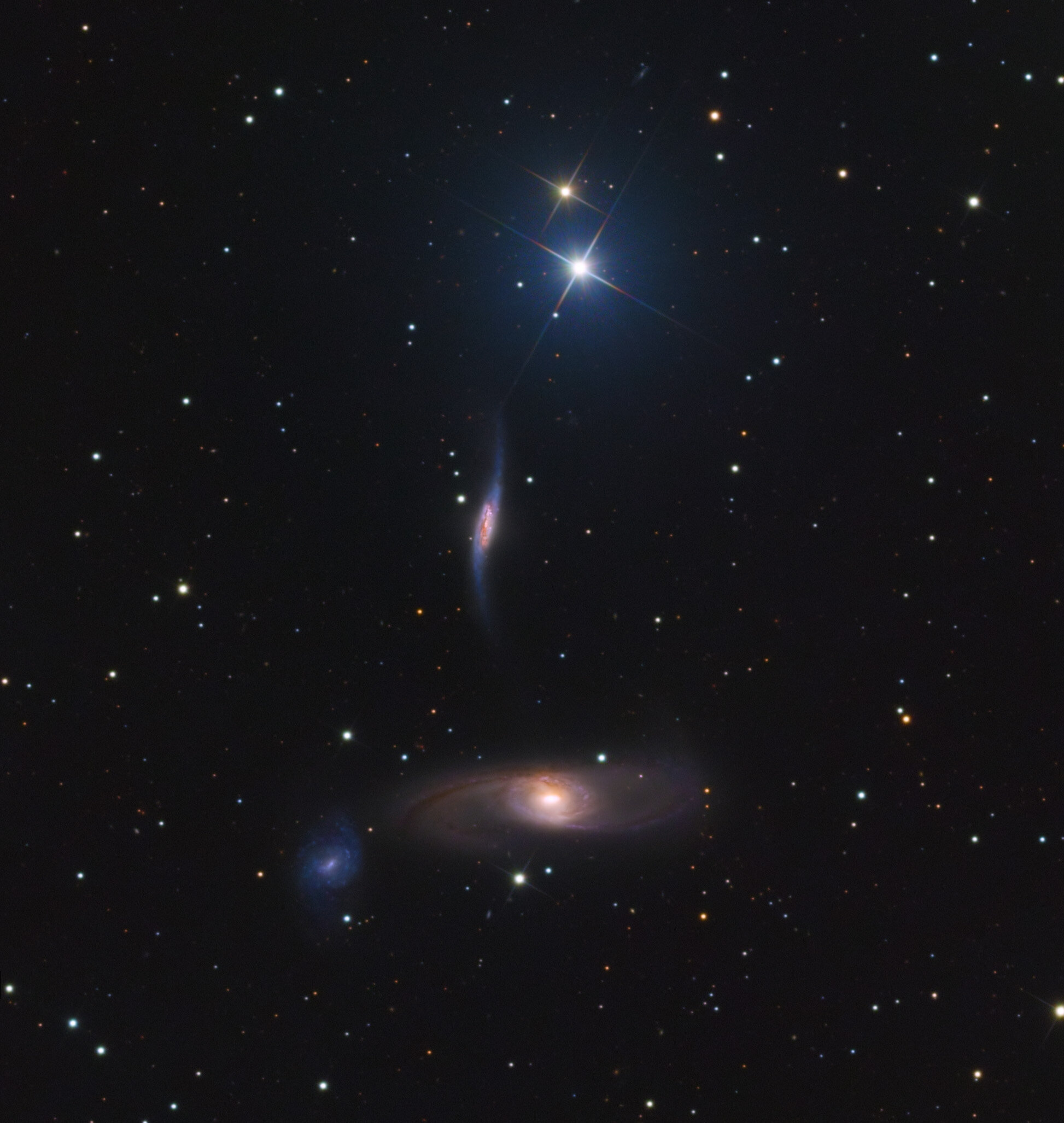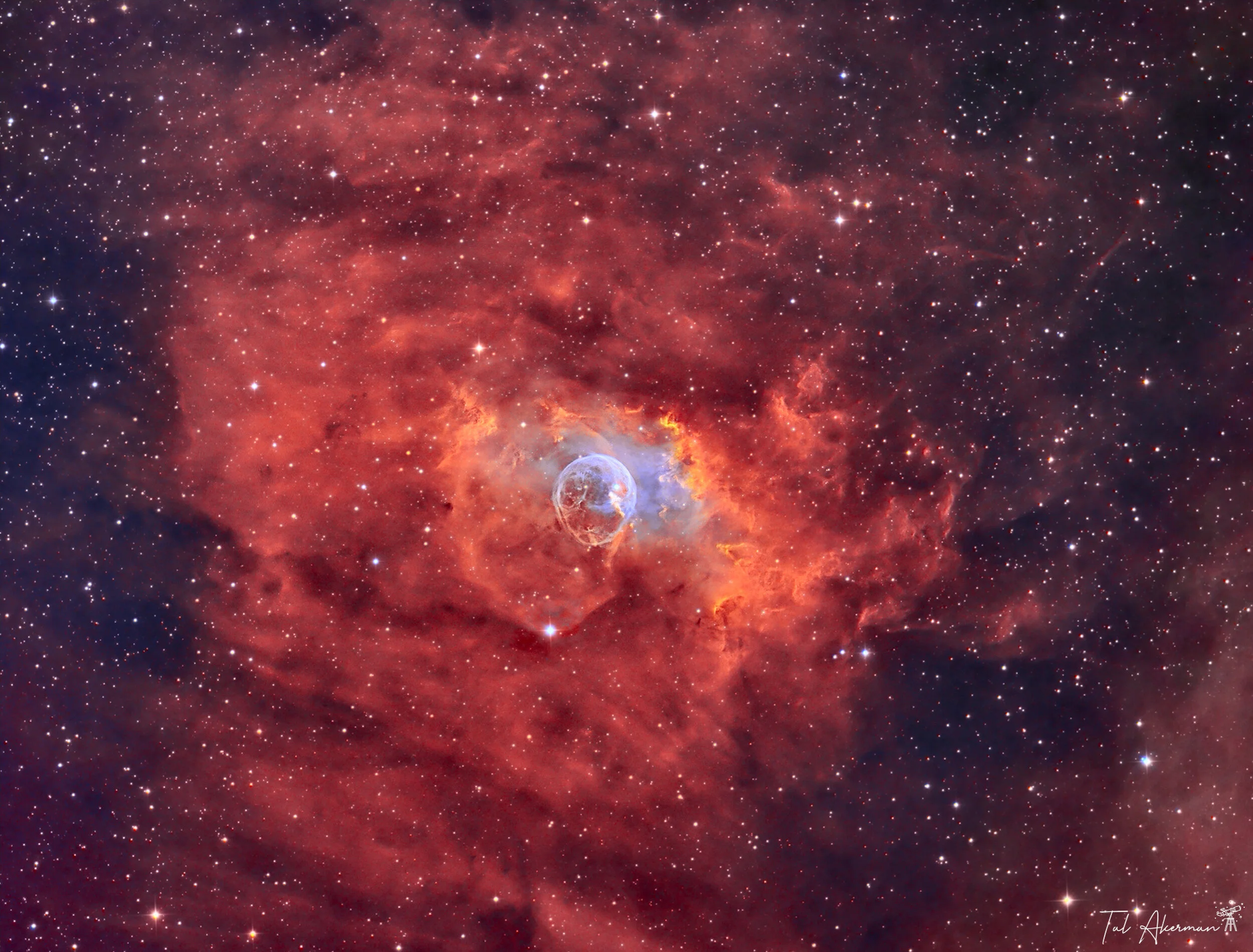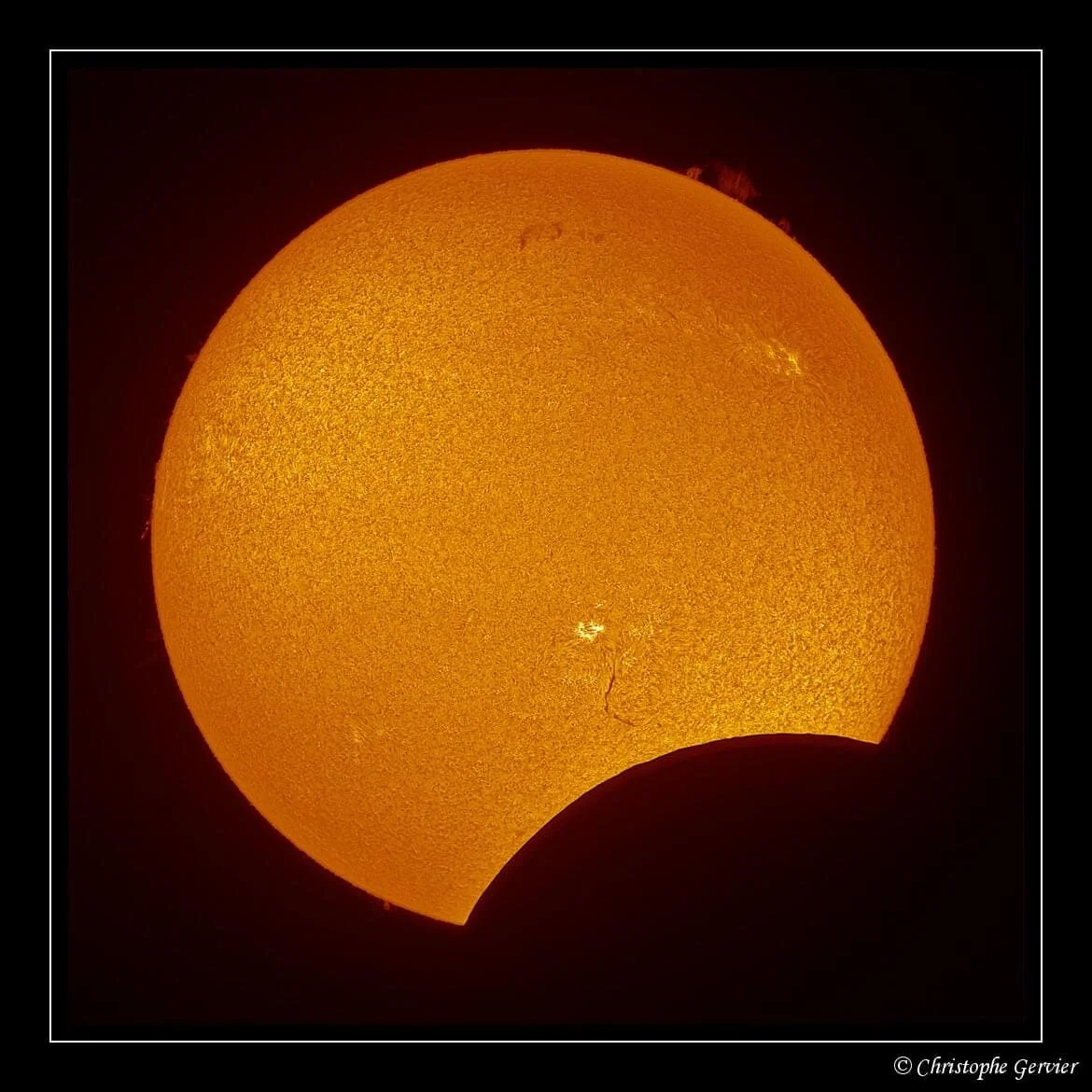
AAPOD2 Image Archives
NGC 6914
Image Description and Details :
NGC 6914 itself is the blue reflection nebula near center. It's surrounded by a wonderful field of glowing gas and dust. Located at approximately 6,000 light-years away in the constellation of Cygnus. Imaged from my backyard in Kitchener, Ontario, Canada. This is 8.5 hours of HaRGB data.
Taken with the Esprit 100 triplet refractor, QHY268M camera and Optolong filters. Processing was done in PixInsight.
Copyright: Shawn Nielsen
Dust around LDN1235
Image Description and Details :
The goal of the image was to go deep enough to show the underlaying dust around this already faint target. Multiple processing techniques were needed to be developed in order to be able to pull out the details on the faintest areas.
Telescope: Borg 101ED f/4
Camera: QHYCCD 163M
Mount: SkyWatcher HEQ 5 Rowan Belt Mod
Exposures:
Optolong B 36mm: 44x300" (3h 40') (gain: 174.00) -10C bin 1x1
Optolong G 36mm: 44x300" (3h 40') (gain: 174.00) -10C bin 1x1
Optolong L 36mm: 163x300" (13h 35') (gain: 174.00) -10C bin 1x1
Optolong R 36mm: 48x300" (4h) (gain: 174.00) -10C bin 1x1
Integration Time: 24h 55m
Copyright: Alberto Ibañez
Monkey Head Nebula
A true winter target, not exactly fitting for Summer solstice, today it’s the longest day of the year.
However it’s about time to finish with my last winter images, to make room for the summer nebulae to come, so here it is.
And although the data was gathering digital dust, is was a lot of fun to process in the end, lots of tiny details and vibrant colors.
The Monkey Head Nebula, NGC 2174, is a HII emission nebula in the constellation of Orion. It’s guesstimated to be located at a distance of 6,400 light-years from earth.
Solar Occultation over Paris with remarkable alignment
Solar occultation on June the 10th, it was very partial in Paris (13%) but I wanted to make that moment unique by looking for a remarkable spot and an ideal frame...
I wanted this photo to be the most scientifically rigorous possible. This is why it need to be mentioned that the shooting is the real one with the exact size and position of the sun over this panorama. I also took the decision to not add false images of the sun to fill the two empty spaces where the sun was fully covered by clouds in Paris.
Few words on the photo : The attached picture is a resized version of 4096pxl to make it transferable, the original photo is about 21000 pixels height for about 1Go (tiff/zip).
Sun was shot with a 200mm lens & solar filter, the background scene shot just before sunrise with a 24mm and also shot with 100mm with 16pictures in panoramic mode (improving resolution). All the course of the sun was also shot with a parallel second DSLR synchronized
Copyright: Pascal Delcroix
Noctilucent clouds over the 45th parallel
Noctilucent clouds over the 45th parallel
This image was taken a few minutes ago from Charente, France. It's the first time I see noctilucent clouds going as high in the sky from where I live. They were covering the sky from the horizon to around an altitude of 70 degrees. As soon as the Sun was continuing its course below the horizon, the clouds at the South East were disappearing, as the ones at the North were becoming more and more visible. In my mind, the image of those subtle draperies will stay forever. Single shot taken with a Canon 6D and a 70-200 2.8 on a tripod.
Copyright: Rémi Boucher-Meunier
NGC 3576
NGC 3576
NGC 3576 is a bright emission nebula, whose popular nickname is "The Statue of Liberty Nebula" because of the distinctive shape in the middle of the nebula. It is approximately 100 light years across and 9000 light-years away from Earth and is located in the Sagittarius arm of our galaxy and a few thousand light-years away from the Eta Carinae nebula. Within the nebula, episodes of star formation are thought to contribute to the complex and suggestive shapes. Powerful winds from the nebula's embedded, young, massive stars shape the looping filaments. It was discovered by William Herschel on 16 March 1834 and the name was first suggested in 2009 by Dr. Steve Mazlin, a member of Star Shadows Remote Observatory (SSRO).
7 hrs each of SHO filters and 30mins each of RGB filters for stars replacement.
Processed in Pixinsight with a final flourish in Photoshop
Copyright: Vikas Chander
Fun with spectroscopy
Image Details:
This image is a comparison of a range of spectra taken of 31 naked eye stars visible from the Southern hemisphere. Spectra were taken with a StarAnalyzer diffraction grating mounted in the filter wheel of my CCD camera on a 12.5" Newtonian telescope. Each spectrum was processed using RSpec software and calibrated for instrument response. The resulting spectra show the black body radiation profile of the various stellar types and their typical spectral line features.The star spectra are ordered according to stellar type, with hot blue stars at the top and cooler red stars towards the bottom. Hot blue stars (O, B, A types) have a light profile heavily skewed towards the left (blue and violet) end of the spectrum given these stars emit the majority of their energy at short wavelengths. They also display the famous Hydrogen Balmer series of absorption lines.In the centre are the F, G and K type stars with their more even light profiles and numerous but fainter absorption lines.Towards the bottom are the cooler M type stars with profiles heavily skewed towards the red and infrared end of the spectrum. They show many broad absorption lines from Titanium Oxide molecules suspended in their atmospheres.At the very bottom are two examples of Wolf-Rayet stars that have unusual spectra with some prominent emission lines.Also visible are a couple of absorption lines in the red, which appear in every single spectrum regardless of spectral type. These are caused by terrestrial oxygen in the Earth's atmosphere.The background image is my deep photo of cometary globules CG 30, CG 31 and CG 38 in Puppis.Date: 29 May, 1 June 2021Exposure: Luminance 0.03s - 3s @ -25CTelescope: Homebuilt 12.5" f/4 Serrurier Truss NewtonianCamera: QSI 683wsg with Lodestar guiderFilters: StarAnalyzer 200 Diffraction GratingTaken from my observatory in Auckland, New Zealand See Less
Copyright: Rolf Olsen
SH2-129 & Ou4
Image Description and Details :
Today I want to show you my most elaborate DeepSky object. And that is SH2-129 & Ou4The Bat and Squid Nebula in the constellation of Cepheus.Ou4 is also called "the flying bat and giant squid nebula". This is the penis-like shape with the special blue-green emissions of double-ionized oxygen atoms. The squid nebula was discovered in 2011 by the French astrophotographer Nicolas Outters and is very faint.Therefore, I took all pictures with a new moon as possible.The entire field is approx. 3 degrees or 6 full moons wide! As a result, I had to make a 4-part mosaic with 6 "f / 4 Newton at 600 mm focal length. So actually a huge object in the night sky.The image processing was then again a challenge. Above all, a picture that was as natural as possible with the "right" colors was important to me. I also like star colors ---------------------------------------------Recording dates: Location: Upper AustriaRecording date: May to June 2021Distance: 2300 light yearsDiameter: 50 light yearsExposure: 122 x 300 sec. For RGB151 x 900 sec. With dual narrowbandTotal: 48 hours Calibration: Darks / Flats / DarkFlatsMount: Skywatcher EQ6-R PROTelescope: TS 6 ″ Newton Carbon 150/600Corrector: Lacerta GPU coma correctorFilters: Astronomik L2 UV-IR Block 2 ″ and Optolong Filter L-eXtreme 2 ″Camera: QHY268c @ Gain 0 at -15 ° CGuiding: ZWO OAG with QHY5III462c and PHD2Heaven: Mag. 21.67Software: APP / Photoshop CC / NHF-sharpen
Copyright: Daniel Nimmervoll
The Smuggler's Cave
Image Description:
What is the creepiest place you ever shot at? For me, it definitely is this cave village which I visited during this year's summer astrophotography trip to the Canary Islands with my buddy Benjamin Barakat
The place was pretty well populated while we scouted it in the afternoon, but it was completely deserted when we arrived in the middle of the night to capture it with the early morning Milky Way.
As we exited out of our car, we were engulfed by pitch black night. Spooky shadows were flying around us, giving off eerie cries. Some sounded like crying babies, while others resembled the coughing of chain smoker with a terrible hangover.
After overcoming our initial shock, we pointed our flashlights into the sky and saw that the shadows were big birds. They did not seem to like our lights though and flew so close to our heads that we felt the flapping of their wings. We quickly dimmed our lights and headed down the trail to the cave. After some research the other day, I found that the birds are relatives of the Albatross, called Cory's Shearwater.
Fortunately, the birds did not follow us into the cave. We set up our cameras and took some test shots. I was completely stunned by how dark the place was. In a three minute exposure at ISO 12'800, only the sky outside the cave confirmed that I had not forgotten to remove my lens cap.
Time to dodge the eerie birds once more. I hiked back to our car to get my low level lights, while my buddy Benjamin found an excuse to wait in the safety of the cave.
Lighting up the place proved to be a tricky task, but after some tinkering with my lights, I found an satisfactory solution and we were finally able to do something productive.
EXIF
Canon EOS Ra
Tamron 15-30mm f/2.8
iOptron SkyTracker Pro
Low Level Lighting
Sky:
Stack of 5 x 60s @ ISO1600
Foreground:
Panorama of 4 panels, each a stack of 5 x 120s @ ISO6400
Copyright: Ralf Rohner
Hockey Stick and Whale galaxies
Image Detail:
Here is the beautiful pair of the Hockey Stick (NGC 4656) and Whale galaxies (NGC 4631) in the constellation Canes Venatici. There are dozens of other more distant galaxies in the background that were too faint to plate solve.
The smaller “Hockey Stick Galaxy” on the left is mainly blue because of the large amount of young blue stars. Typically, abundance of star birth activity indicates some violent event, which triggered the condensation of gas clouds into proto-stars, which lead to occurrence of many new young stars. Such event is very often merger of two galaxies and the slightly irregular shape of NGC4656 and also streams of stars reaching far from the galaxy spiral arms hint such merger occurred only recently.
The larger Whale Galaxy at right is probably rather typical spiral galaxy, but visible from the side. It shows a yellow and orange central bulge, composed mainly of old stars, as well as dark interstellar dust lanes and dark reddish hydrogen clouds around the galaxy disk. Light blue portions indicate presence of many bright, young blue stars consuming the outer arms.
OTA: Explore Scientific ED152 Air-Spaced Triplet 1216mm focal length f/8Mount: Celestron CGX-LCamera: ZWO ASI2600MM ProGain: 100Cooling Temperature: -10 CelsiusAuto-guiding: ZWO ASI174MM Mini and ZWO M68 OAGControl: ZWO ASIAIR ProFilters: 2" Astronomik L3, RGB (CCD), Ha (12nm)
Acquisition:L 60 x 300s = 5 hoursR 31 x 600s = 5.2 hoursG 31 x 600s = 5.2 hoursB 31 x 600s = 5.2 hoursHa 15 x 900s = 3.75 hours24.35 hours total
Flagstaff, AZ - Bortle 4 skiesCalibrated in Astro Pixel Processor with darks and flatsProcessed in Pixinsight and Lightroom
Copyright: Drew Evans
tarantula nebula - NGC 2070
Image Description:
At the beginning of our presentation of the southern sky, we see the spectacular tarantula nebula, catalogue NGC 2070 or 30 Doradus, today in the constellation Swordfish. The last name comes from the explorer Nicolas Louis de Lacaille who saw him as a star in 1751 and therefore gave a star number. The fog is located in the Great Magellanian cloud approx. 163 000 light years away.
It is one of the largest star emerging areas in our local galaxy group. He is stimulated by the star cluster R136 in his midst. The pile houses the most well-known and brightest star R136a1 with 265 solar masses and 10 million times luminosity and another two stars with about 150 solar masses.
Copyright: Hans Bernd Dörfeldt
NGC 6946 - The Fireworks Galaxy
Image Description and Details :
This is an image of NGC 6946, also known as the Fireworks Galaxy. It is a face-on intermediate spiral galaxy about 25 million light years away near the boundary of the constellations of Cepheus and Cygnus. It spans about 40,000 light years in diameter, which is about one third the size of the Milky Way. It is classified as a starburst galaxy which means there is a lot of star forming regions as can be seen in the magenta regions in the image.
Telescope: Planewave CDK-17
Camera: FLI PL16803
Mount: Paramount ME
Luminance: 27x20 minutes (binned 1x1)
Red: 16x15 minutes (binned 1x1)
Green: 16x15 minutes (binned 1x1)
Blue: 16x15 minutes (binned 1x1)
Copyright: Bernard Miller
LDN 673 & LDN 684
Image Description and Details :
LDN 673 (Lynds’ Dark Nebula 673) is a highly fractured and very dense dark cloud complex about 600 light-years from Earth in the constellation Aquila. It is located near the center of the Aquila Rift, a great mass of dark molecular clouds along the summer Milky Way through the constellations Aquila, Serpens, and eastern Ophiuchus. This molecular cloud make the distant stars appear reddish, while the very dense LDN 673 nebula completely blocks the starlight.
In silhouette against the Milky Way’s faint starlight, LDN 673’s dusty molecular clouds likely contain raw material to form hundreds of thousands of stars. Visible indications of energetic outflows associated with young stars include the small red tinted nebulosity RNO 109 (GN 19.18.0) and several Herbig-Haro objects, like HH 32 near the young variable T-Tauri star V1352 (AS 353). These objects are signs of active star formation.
Telescope: ASA 10" Astrograph
Mount: ASA DDM60
Camera: Moravian G3-16200
4-panel mosaic with a total exposure time of 20h 30min
Copyright: Thomas Henne
Crescent and Tulip Nebulae Wide field
Image Description and Details : Widefield image of a nebula-dense region in the constellation Cygnus. The image contains the crescent nebula in the top right and the tulip nebula in the lower left.
OIII: 120x300" (10h) bin 1x1
Hɑ: 135x300" (11h 15') bin 1x1
SII: 106x300" (8h 50') bin 1x1
Gain: 111.00; -15C
Total Integration: 30h
Camera: ZWO 183MM Pro
Lens: Rokinon 135 f/2
Mount: Sky-Watcher EQ6R Pro
Copyright: Frank Turina
Leo Triplet
Image Description and Details :
Leo Triplet, the three galaxies M65 - M66 and NGC3628 with its Tidal Tail.
Telescope: Takahashi FSQ 106 - Unguided CCD: QSI 683 ws8 LRGB Baader planetarium filters Mount: 10 Micron HPS1000 Rotator: Pegasus Focuser: Lunatic Armadillo Software: Mountwizar 4, Voyager, Pixinsight
"FAR LIGHT TEAM" Remote Observatory in Spain ( Fregenal de la Sierra ) Badajoz, Extremadura Region, in the hosting of telescopes "Entre Encinas y Estrellas". Photographic work done during the month of May 2021
Authors and copyright : Marc Valero, Bittor Zabalegui, José Esteban & Jesús M. Vargas
Lights: ( -15º ) Luminance 44 x 1200" bininx1 Luminance 25 x 200" bininx1 R 20 x 300" bininx2 G 20 x 300" bininx2 B 20 x 300" bininx2
Calibration: ( -15º ) 50 DARKS x 1200" bininx1 100 DARKS x 200" bininx1 75 DARKS x 300" bininx2
200 BIAS bininx1 200 BIAS bininx2
60 FLATS Luminance 60 FLATS Blue 60 FLATS Green 60 FLATS Red
Website or Facebook Profile: https://www.flickr.com/photos/190787445@N02/albums
Copyright: Authors and copyright : Marc Valero, Bittor Zabalegui, José Esteban & Jesús M. Vargas
Jupiter's GRS rapid changes
Image Description and Details :
Jupiter can be even more dynamic in regions close to storms. Here we can observe the variation in the atmosphere close to GRS in an interval of only 3 days. The gas giant's best sighting season has just begun!
Celestron C8 @ f/20, ASI290, orhto 7mm, uv-ir cut
Copyright: Carlos Alberto Palhares
The Bubble Nebula
Image Description and Details :
53 Hours of SHO and RGB Stars !
This project was in my bucket list for a long time, mainly because the Bubble was the reason I started with astrophotography.
oh boy I'm happy with this final version
Astrodon Ha 3nm - 80x900s (20 hours)
Astrodon Oiii 3nm - 60x900s (15 hours)
Astrodon Sii 3nm - 60x900s (15 hours)
Chroma Red - 60x60s
Chroma Green - 60x60s
Chroma Blue - 60x60s
Telescope - GSO RC 8" Carbon Tube
Mount iOptron CEM70
Camera - ZWO ASI 1600mm Pro
Guide Camera - OAG + ZWO ASI174mm Mini
Copyright: Tal Akerman
Partial solar eclipse
Partial solar eclipse of the day from the South-West of France
- Orion 80ED
- Coronado SolarMax 60
- ZWO ASI 174MM
- SharpCap, post-processing AutoStakkert v3, Registax 6, Photoshop and Lightroom.
Copyright: Christophe Gervier





















